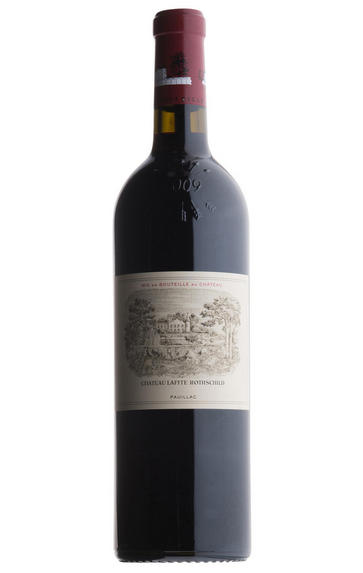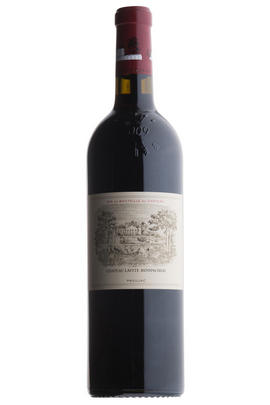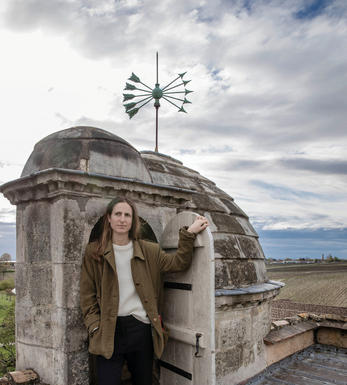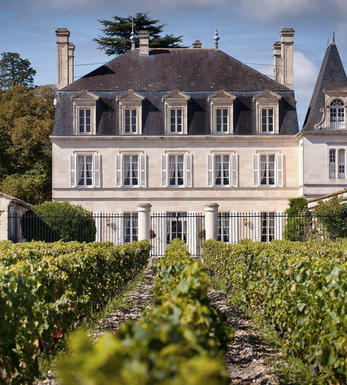
2008 Château Lafite Rothschild, Pauillac, Bordeaux

Critics reviews
The 2008 Lafite Rothschild put in a strange showing at the previous horizontal just a few weeks earlier. This bottle is much better. It has a deep color with little ageing on the rim. On the nose there is ample fruit, blackberry and bilberry with notes of pencil lead and sage, but overall there is just more intensity than the previous bottle. The palate is well balanced with fine grain tannin and good density, a facet occasionally lacking in Lafite-Rothschild. There is just a touch of brown sugar and sage towards the finish that fortunately does not attenuate like the previous bottle. This is much more representative and whilst not the best First Growth of the vintage, it certainly shows more sophistication and class even if it does not match its more stellar showings just after bottling. Tasted blind at Farr Vintners’ 10-Year On tasting.
Drink 2020 - 2045
Neal Martin, Vinous.com (May 2018)
A blend of 83% Cabernet Sauvignon, 13% Merlot and 4% Cabernet Franc.
Deep purple-ruby. Dense, rich, absolutely classic Lafite nose redolent of blackcurrant, cedar and graphite. Enters fat, with blackberry, licorice and underbrush flavors framed by strong but harmonious acids and youthful tannins that will need time to resolve. This is presently the most backward and closed of the Medoc first growths in '08, but should prove spectacular in time: insiders know that cooler vintages such as '08 are perfectly suited to Lafite's terroir, a case in point being the '88, an initially austere wine that has come around magnificently.
Ian D'Agata, Vinous.com (May 2009)
A candidate for the -wine of the vintage,- the 2008 should have been purchased before it began to soar in value because of the significance of the number 8 in the Chinese culture (denoting good luck). Representing 40% of the production, this blend of 83% Cabernet Sauvignon, 13% Merlot and 4% Cabernet Franc offers aromas of high quality unsmoked cigar tobacco, lead pencil shavings, creme de cassis, earth, cedar and asphalt. Full, rich and stunningly concentrated, I doubt it is inferior to the 2010, just more classic as well as slightly more forward and a degree weaker in alcoholic potency (12.5% versus 13.5%). The 2008 should be relatively drinkable in 6-10 years as it is already showing remarkable complexity and breed, and will last for 30-35 years...at the minimum.
Drink 2017 - 2052
Robert M. Parker, Jr., Wine Advocate (May 2011)
Tasted blind. Round, easy and charming on the nose. Dry end on the palate. Correct but not very fruity. Bit dry. Herbs, Chartreuse scents.
Drink 2018 - 2038
Jancis Robinson MW, JancisRobinson.com (March 2018)
Minerals, tar and sous bois with dark fruit. Sweet tobacco. Black licorice. Full and chewy with lots of fruit but very reserved. So much mineral and sweet tobacco. It is all there. Give it four to five years of bottle age before beginning to explore the wine.
James Suckling, JamesSuckling.com (December 2010)
Extremely Cabernet dominant, with savoury black fruit and a ton of Pauillac character. A fairly reserved, finely-boned Lafite, with menthol and tobacco leaf. Subdued right now but in it for the long haul. The vintage with the Chinese symbol for eight engraved on the bottle, to commemorate the planting of the Long Dai vineyard in China - a fact that made the price of this bottle shoot up when it was released. Harvest October 1 to 14. 40% of overall production.
Drink 2021 - 2038
Jane Anson, Decanter.com (February 2021)
The 2008 Lafite-Rothschild is one of the few wines that’s still obviously closed and backward, yet nevertheless shows incredible potential. Made from a blend of 83% Cabernet Sauvignon, 13% Merlot, and 4% Cabernet Franc (which is more Merlot than normal), it offers textbook Lafite elegance and class in its perfume of lead pencil, cedarwood, cigar smoke, and mineral-laced black fruits. Playing in the medium to full-bodied spectrum, it’s deceivingly concentrated and powerful due to its perfect balance and purity as well as weightless texture. Hide bottles for 4-5 years and enjoy this classic Lafite over the following 30 years or so.
Drink 2023 - 2053
Jeb Dunnuck, JebDunnuck.com (February 2019)
Full ruby-red with a purple tinge. Crushed cassis, blackberry, violet, cedar and graphite on the very fresh, complex nose. Juicy, spicy and penetrating, with lovely harmonious acids providing great clarity and cut to the black fruit and graphite flavors. Still youthfully closed and very mineral. Finishes pure and extremely long, with very fine tannins. This may yet turn out to be the wine of the vintage, but it will require patience.
Stephen Tanzer, Vinous.com (July 2011)
About this WINE

Château Lafite Rothschild
The iconic Château Lafite Rothschild was classified as a first growth in 1855 and has been in the Rothschild family since 1868. Today, Lafite is headed up by Saskia de Rothschild, daughter of long-time steward Baron Eric de Rothschild.
Château Lafite Rothschild is an iconic first-growth property in the Pauillac appellation of Bordeaux, France. It achieved its top-tier rank in 1855 and has been in the Rothschild family since 1868. Today, Lafite is headed up by Saskia de Rothschild, daughter of long-time steward Baron Eric de Rothschild.
The property is located at the northern tip of Pauillac, separated by St Estèphe by marshland and the Jalle de Breuil stream. Two areas of the vineyard are particularly notable: the gravel plateau, which is the heart of the grand vin; and the Plateau de Carruades, from which Lafite’s second wine takes its name. The vineyard is planted mostly to Cabernet Sauvignon (70%), along with Merlot (25%), Cabernet Franc (3%) and Petit Verdot (2%).
A new cellar was completed here in time for the 2011 harvest, with a combination of stainless steel and concrete tanks, of varying sizes. The barrels come from Lafite’s own cooperage, located not far from the property.
In addition to its 110 hectares of vines, the estate has 300 hectares of woods and marshes. The team consider this to be an integral part of the ecosystem.

Pauillac
Pauillac is the aristocrat of the Médoc boasting boasting 75 percent of the region’s First Growths and with Grand Cru Classés representing 84 percent of Pauillac's production.
For a small town, surrounded by so many familiar and regal names, Pauillac imparts a slightly seedy impression. There are no grand hotels or restaurants – with the honourable exception of the establishments owned by Jean-Michel Cazes – rather a small port and yacht harbour, and a dominant petrochemical plant.
Yet outside the town, , there is arguably the greatest concentration of fabulous vineyards throughout all Bordeaux, including three of the five First Growths. Bordering St Estèphe to the north and St Julien to the south, Pauillac has fine, deep gravel soils with important iron and marl deposits, and a subtle, softly-rolling landscape, cut by a series of small streams running into the Gironde. The vineyards are located on two gravel-rich plateaux, one to the northwest of the town of Pauillac and the other to the south, with the vines reaching a greater depth than anywhere else in the Médoc.
Pauillac's first growths each have their own unique characteristics; Lafite Rothschild, tucked in the northern part of Pauillac on the St Estèphe border, produces Pauillac's most aromatically complex and subtly-flavoured wine. Mouton Rothschild's vineyards lie on a well-drained gravel ridge and - with its high percentage of Cabernet Sauvignon - can produce (in its best years) Pauillac's most decadently rich, fleshy and exotic wine.
Latour, arguably Bordeaux's most consistent First Growth, is located in southern Pauillac next to St Julien. Its soil is gravel-rich with superb drainage, and Latour's vines penetrate as far as five metres into the soil. It produces perhaps the most long-lived wines of the Médoc.
Recommended Châteaux
Ch. Lafite-Rothschild, Ch. Latour, Ch. Mouton-Rothschild, Ch. Pichon-Longueville Baron, Ch. Pichon Longueville Comtesse de Lalande, Ch. Lynch-Bages, Ch. Grand-Puy-Lacoste, Ch, Pontet-Canet, Les Forts de Latour, Ch. Haut-Batailley, Ch. Batailley, Ch. Haut-Bages Libéral.

Cabernet Sauvignon Blend
Cabernet Sauvignon lends itself particularly well in blends with Merlot. This is actually the archetypal Bordeaux blend, though in different proportions in the sub-regions and sometimes topped up with Cabernet Franc, Malbec, and Petit Verdot.
In the Médoc and Graves the percentage of Cabernet Sauvignon in the blend can range from 95% (Mouton-Rothschild) to as low as 40%. It is particularly suited to the dry, warm, free- draining, gravel-rich soils and is responsible for the redolent cassis characteristics as well as the depth of colour, tannic structure and pronounced acidity of Médoc wines. However 100% Cabernet Sauvignon wines can be slightly hollow-tasting in the middle palate and Merlot with its generous, fleshy fruit flavours acts as a perfect foil by filling in this cavity.
In St-Emilion and Pomerol, the blends are Merlot dominated as Cabernet Sauvignon can struggle to ripen there - when it is included, it adds structure and body to the wine. Sassicaia is the most famous Bordeaux blend in Italy and has spawned many imitations, whereby the blend is now firmly established in the New World and particularly in California and Australia.


Buying options
Add to wishlist
Description
Extremely Cabernet dominant, with savoury black fruit and a ton of Pauillac character. A fairly reserved, finely-boned Lafite, with menthol and tobacco leaf. Subdued right now but in it for the long haul. The vintage with the Chinese symbol for eight engraved on the bottle, to commemorate the planting of the Long Dai vineyard in China - a fact that made the price of this bottle shoot up when it was released. Harvest October 1 to 14. 40% of overall production.
Drink 2021 - 2038
Jane Anson, Decanter.com (February 2021)
wine at a glance
Delivery and quality guarantee